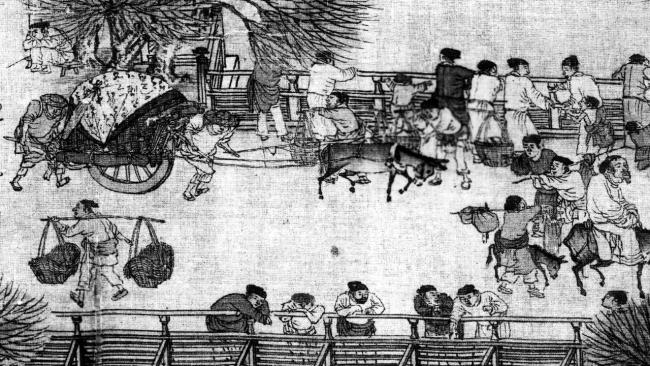
Twelfth-century life in the Song capital: Zhang Zeduan's 'Spring Festival on the River'
The China Centre seminar on Tuesday 17 May 2022 was given by Professor Roderick Whitfield, Percival David Professor, Emeritus, SOAS, University of London.
Professor Whitfield's lecture examined the twelfth century Chinese scroll painting, 'Spring Festival on the River' (Qingming shanghe tu, literally: Going up the River on the Qingming Festival) painted by Zhang Zeduan. The painting is 26 cm wide and 525 cm in length. Professor Whitfield explained the cultural context of Chinese scroll paintings, both horizontal and vertical, as well as the technology behind the production of the silk cloth that was the physical foundation for scroll paintings.
The main body of Professor Whitfield's lecture was devoted to a detailed examination of the scenes depicted in the painting. The painting portrays life in the city of Bianjing (present day Kaifeng), the capital city of the Norther Song Dynasty. The scenes begin with a stark, desolate landscape, with poor people in front of simple, thatched dwellings. As the painting progresses into the centre of the city, the activity becomes progressively more intense. The core of the painting is full of bustling commercial activity, with a multitude of boats on the Bian canal, which was the artery for trade between north and central China. The picture provides detailed views of life on board the boats as well as along the bustling streets and within buildings. Professor Whitfield directed the viewers' attention to a multitude of details, such as the swirling patterns in the water and the great variety of business activities on display, including grain traders, restaurants, butchers' shops, wine shops, textile shops, incense sellers, fortune tellers, night soil collectors, and medical practitioners. Professor Whitfield noted that the painting contains detailed portraits of over 800 human beings.
The Q&A segment of the seminar included discussion of the following issues: the role of portrait painting versus architectural and landscape in Chinese painting; the understanding of perspective in Chinese painting; the source of Zhang Zeduan's detailed knowledge of boat technologies; the structural composition of the Qingming shanghe tu; the role of willow trees in the painting; the significance of the painting in relation to flourishing trade during the Song Dynasty; and the significance of the painting as a commentary on the downfall of Emperor Hui Zong (1082-1135).
Roderick Whitfield, Percival David Professor, Emeritus, was educated at home and King Edward's School, Birmingham. From 1955 to 1957 he studied modern Chinese at the School of Oriental and African Studies, then classical Chinese at Cambridge University with Denis Twitchett and Cheng Te-k'un, graduating in 1960. From 1960 to 1965 he studied Chinese Art and Archaeology at Princeton University with Professor Wen Fong and Professor Shimada Shujirõ. His dissertation topic was Zhang Zeduan’s Spring Festival on the River, the subject of this lecture.
After a further year at Princeton as Lecturer and assistant to Peter Swann in setting up the Asian Gallery of the rebuilt Princeton Art Museum, Roderick Whitfield returned to St John's College, Cambridge as Research Fellow. In 1968 he was appointed Assistant Keeper in the Department of Oriental Antiquities (now Department of Asia) at the British Museum, leaving in 1984 to be Head of the Percival David Foundation and Professor of Chinese and East Asian art.
A Visiting Research Fellow at the Dunhuang Academy and the Palace Museum, Beijing, Professor Whitfield's research interests and publications include Chinese traditional painting, Buddhist art from Dunhuang and other cave-temple sites, Korean art and the conservation of East Asian paintings.





